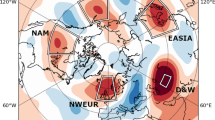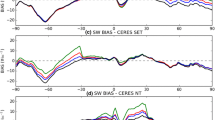Abstract
The secular trends and interannual variability of wintertime temperatures over northern extratropical lands and circulations over the northern hemisphere are examined using the NCEP/NCAR reanalysis from 1961 to 2010. A primitive equation dry atmospheric model, driven by time-averaged forcing in each winter diagnosed from the NCEP reanalysis, is then employed to investigate the influences of tropical and extratropical forcing on the temperature and circulation variability. The model has no topography and the forcing is thus model specific. The dynamic and thermodynamic maintenances of the circulation and temperature anomalies are also diagnosed. Distinct surface temperature trends over 1961–1990 and 1991–2010 are found over most of the extratropical lands. The trend is stronger in the last two decades than that before 1990, particularly over eastern Canadian Arctic, Greenland, and Asia. The exchange of midlatitude and polar air supports the temperature trends. Both the diagnosed extratropical and tropical forcings contribute to the temperature and circulation trends over 1961–1990, while the extratropical forcing dominates tropical forcing for the trends over 1991–2010. The contribution of the tropical forcing to the trends is sensitive to the period considered. The temperature and circulation responses to the diagnosed tropical and extratropical forcings are approximately additive and partially offsetting. Covariances between the interannual surface temperature and 500-hPa geopotential anomalies for the NCEP reanalysis from 1961 to 2010 are dominated by two leading modes associated with the North Atlantic Oscillation (NAO) and Pacific-North American (PNA) teleconnection patterns. The diagnosed extratropical forcing accounts for a significant part of the NAO and PNA associated variability, including the interannual variability of stationary wave anomalies, as well as dynamically and thermodynamically synoptic eddy feedbacks over the North Atlantic and North Pacific. The tropical forcing contributes to the PNA related temperature and circulation variability, but has a small contribution to the NAO associated variability. Additionally, relative contributions of tropical Indian and Pacific forcings are also assessed.












Similar content being viewed by others
References
Alexander MA, Lau N-C, Scott JD (2004) Broadening the atmospheric bridge paradigm: ENSO teleconnections to the tropical West Pacific-Indian Oceans over the seasonal cycle and to the North Pacific in summer. Earth’s Climate: The Ocean–Atmosphere Interactions, Geophys Monogr, vol 147, Amer Geophys Union, pp 85–103
Bader J, Latif M (2003) The impact of decadal-scale Indian Ocean sea surface temperature anomalies on Sahelian rainfall and the North Atlantic Oscillation. Geophys Res Lett 30:2169. doi:10.1029/2003GL018426
Barlow M, Nigam S, Berbery EH (2001) ENSO, Pacific decadal variability, and U.S. summertime precipitation, drought, and stream flow. J Clim 14:2105–2128
Barsugli JJ, Battisti DS (1998) The basic effects of atmosphere–ocean thermal coupling on midlatitude variability. J Atmos Sci 55:477–493
Berrisford PD, Dee K, Fielding M, Fuentes P, Kallberg S, Kobayashi, Uppala S (2009) The ERA-interim archive, ERA report series 1, ECMWF, Shinfield Park, Reading
Branstator G (1995) Organization of storm track anomalies by recurring low-frequency circulation anomalies. J Atmos Sci 52:207–226
Chan J, Zhou W (2005) PDO, ENSO and the early summer monsoon rainfall over south China. Geophys Res Lett 32:L08810. doi:10.1029/2004GL022015
Choi DH, Kug JS, Kwon WT, Jin FF, Baek HJ, Min SK (2010) Arctic oscillation responses to greenhouse warming and role of synoptic eddy feedback. J Geophys Res 115:D17103. doi:10.1029/2010JD014160
Cohen J, Entekhabi D (1999) Eurasian snow cover variability and Northern Hemisphere climate predictability. Geophys Res Lett 26:345–348
Copsey D, Sutton R, Knight JR (2006) Recent trends in sea level pressure in the Indian Ocean region. Geophys Res Lett 33:L19712. doi:10.1029/2006GL027175
Dettinger MD, Cayan DR, Diaz HF, Meko DM (1998) North–south precipitation patterns in western North America on interannual to decadal timescales. J Clim 11:3095–3111
Favre A, Gershunov A (2006) Extra-tropical cyclonic/anticyclonic activity in North-Eastern Pacific and air temperature extremes in Western North America. Clim Dyn 26:617–629
Feldstein SB (2003) The dynamics of NAO teleconnection pattern growth and decay. Quart J Roy Meteor Soc 129:901–924
Fletcher CG, Kushner PJ (2011) The role of linear interference in the annular mode response to tropical SST forcing. J Clim 24:778–794
Frankignoul C (1985) Sea surface temperature anomalies, planetary waves and air–sea feedback in the middle latitudes. Rev Geophys 23:357–390
Gershunov A, Barnett TP (1998) Interdecadal modulation of ENSO teleconnections. Bull Am Meteor Soc 79:2715–2725
Greatbatch RJ, Lin H, Lu J, Peterson KA, Derome J (2003) Tropical/extratropical forcing of the AO/NAO: a corrigendum. Geophys Res Lett 30(14):1738. doi:10.1029/2003GL017406
Hall NMJ (2000) A simple GCM based on dry dynamics and constant forcing. J Atmos Sci 57:1557–1572
Hall NMJ, Derome J, Lin H (2001a) The extratropical signal generated by a midlatitude SST anomaly part I: sensitivity at equilibrium. J Clim 14:2035–2052
Hall NMJ, Lin H, Derome J (2001b) The extratropical signal generated by a midlatitude SST anomaly part II: influence on seasonal forecasts. J Clim 14:2696–2709
Halpert MS, Ropelewski CF (1992) Surface temperature patterns associated with the Southern Oscillation. J Clim 5:577–593
Hansen J, Ruedy R, Sato M, Lo K (2010) Global surface temperature change. Rev Geophys 48:RG4004. doi:10.1029/2010RG000345
Hare SR, Mantua NJ (2000) Empirical evidence for North Pacific regime shifts in 1977 and 1989. Prog Oceanogr 47:103–145
Hartmann DL (1995) A PV view of zonal flow vacillation. J Atmos Sci 52:2561–2576
Hildebrand FB (1956) Introduction to numerical analysis. McGraw-Hill, New York
Hoerling MP, Hurrell JW, Xu T, Bates GT, Phillips AS (2004) Twentieth century North Atlantic climate change. Part II: understanding the effect of Indian Ocean warming. Clim Dyn 23:391–405
Horel JD, Wallace JM (1981) Planetary-scale atmospheric phenomena associated with the Southern Oscillation. Mon Wea Rev 109:813–829
Hurrell JW (1995) Decadal trends in the North Atlantic Oscillation: regional temperatures and precipitation. Science 269:676–679
Hurrell JW, van Loon H (1997) Decadal variations associated with the North Atlantic Oscillation. Climat Change 36:301–326
Hurrell JW, Kushnir Y, Visbeck M, Ottersen G (2003) An overview of the North Atlantic Oscillation. In: Hurrell JW et al. (eds) The North Atlantic Oscillation: climate significance and environmental impact. Geophysical Monograph Series, vol 134, pp 1–35
Karoly DJ, Plumb RA, Ting M (1989) Examples of the horizontal propagation of quasi-stationary waves. J Atmos Sci 46:2802–2811
Kistler R et al (2001) The NCEP-NCAR 50-year reanalysis: monthly means CD-ROM and documentation. Bull Amer Meteor Soc 82:247–268
Kug JS, Jin FF (2009) Left-hand rule for synoptic eddy feedback on low-frequency flow. Geophys Res Lett 36:L05709. doi:10.1029/2008GL036435
Kumar A, Hoerling MP (2003) The nature and causes for the delayed atmospheric response to El Niño. J Clim 16:1391–1403
Kumar A, Yang F (2003) Comparative influence of snow and SST variability on extratropical climate in Northern Winter. J Clim 16:2248–2261
Kushnir Y, Robinson WA, Blade I, Hall NMJ, Peng S, Sutton R (2002) Atmospheric GCM response to extratropical SST anomalies: synthesis and evaluation. J Clim 15:2233–2256
Lau N-C (1988) Variability of the observed midlatitude storm tracks in relation to the low-frequency changes in the circulation pattern. J Atmos Sci 45:2718–2743
Lau N-C, Holopainen E (1984) Transient eddy forcing of the time-mean flow as identified by geopotential tendencies. J Atmos Sci 41:313–328
Lau N-C, Nath MJ (1991) Variability of the baroclinic and barotropic transient eddy forcing associated with monthly changes in the midlatitude storm tracks. J Atmos Sci 48:2589–2613
Lau K-M, Kim K-M, Yang S (2000) Dynamical and boundary forcing characteristics of regional components of the Asian summer monsoon. J Clim 13:2461–2482
Lau N-C, Leetmaa A, Nath MJ (2006) Attribution of atmospheric variations in the 1997–2003 period to SST anomalies in the Pacific and Indian Ocean basins. J Clim 19:3607–3628
Lau N-C, Leetmaa A, Nath MJ (2008) Interactions between the responses of North American climate to El Niño–La Niña and to the secular warming trend in the Indian–Western Pacific Oceans. J Clim 21:476–494
Lin H, Derome J (1997) On the modification of the high and low-frequency eddies associated with PNA anomaly: an observational study. Tellus 49A:87–99
Lin H, Derome J, Peterson KA, Greatbatch RJ, Lu J (2002) Tropical links of the Arctic Oscillation. Geophys Res Lett 29(20):1943–1947
Lin H, Brunet G, Derome J (2007) Intraseasonal variability in a dry atmospheric model. J Atmos Sci 64:2422–2441
Liu Z, Alexander M (2007) Atmospheric bridge, oceanic tunnel, and global climatic teleconnections. Rev Geophys 45:RG2005. doi:10.1029/2005RG000172
Lo TT, Hsu HH (2010) Change in the dominant decadal patterns and the late 1980s abrupt warming in the extratropical Northern Hemisphere. Atmos Sci Lett 11:210–215
Mantua NJ, Hare SR, Zhang Y, Wallace JM, Francis RC (1997) A Pacific interdecadal climate oscillation with impacts on salmon production. Bull Am Meteorol Soc 78:1069–1079
Merrifield MA (2011) A shift in western tropical Pacific sea level trends during the 1990s. J Clim 24:4126–4138
Mo K, Rasmusson EM (1993) The 200-mb climatological vorticity budget during 1986–1989 as revealed by NMC analyses. J Clim 6:577–594
Murakami M (1979) Large-scale aspects of deep convective activity over the GATE area. Mon Wea Rev 107:994–1013
Peixoto J, Oort A (1992) The physics of climate. AIP, NY
Peterson KA, Greatbatch RJ, Lu J, Lin H, Derome J (2002) Hindcasting the NAO using diabatic forcing of a simple AGCM. Geophys Res Lett, 29(9). doi:10.1029/2001GL014502
Plumb RA (1985) On the three-dimensional propagation of stationary waves. J Atmos Sci 42:217–229
Rasmusson EM, Mo K (1993) Linkages between 200-mb tropical and extratropical circulation anomalies during the 1986–1989 ENSO cycle. J Clim 6:595–616
Rodionov SN, Overland JE (2005) Application of a sequential regime shift detection method to the Bering Sea ecosystem. ICES J Mar Sci 62:328–332
Rogers JC (1990) Patterns of low-frequency monthly sea level pressure variability (1899–1986) and associated wave cyclone frequencies. J Clim 3:1364–1379
Ropelewski CF, Halpert MS (1987) Global and regional scale precipitation patterns associated with the El Niño/Southern Oscillation. Mon Wea Rev 115:1606–1626
Sardeshmukh PD, Hoskins BJ (1988) The generation of global rotational flow by steady idealized tropical divergence. J Atmos Sci 45:1228–1251
Seager R, Harnik N, Kushnir Y, Robinson W, Miller J (2003) Mechanisms of hemispherically symmetric climate variability. J Clim 16:2960–2978
Shimizu MH, Cavalcanti IFA (2011) Variability patterns of Rossby wave source. Clim Dyn 37:441–454
Shin S-I, Sardeshmukh PD (2011) Critical influence of the pattern of Tropical Ocean warming on remote climate trends. Clim Dyn 36:1577–1591
Shukla J, Wallace JM (1983) Numerical simulation of the atmospheric response to equatorial Pacific Sea surface temperature anomalies. J Atmos Sci 40:1613–1630
Teng Q, Fyfe JC, Monahan AH (2007) Northern hemisphere circulation regimes: observed, simulated and predicted. Clim Dyn 28:867–879
Thompson DWJ, Wallace JM (1998) The Arctic Oscillation signature in wintertime geopotential height and temperature fields. Geophys Res Lett 25:1297–1300
Thompson DWJ, Wallace JM (2001) Regional climate impacts of the Northern Hemisphere annular mode. Science 293:85–89
Trenberth KE, Hurrell JW (1994) Decadal atmosphere-ocean variations in the Pacific. Clim Dyn 9:303–319
Trenberth KE, Branstator G, Karoly D, Kumar A, Lau N-C, Ropelewski C (1998) Progress during TOGA in understanding and modeling global teleconnections associated with tropical sea surface temperatures. J Geophys Res 103:14291–14324
Uppala SM et al (2005) The ERA-40 re-analysis. Quart J Roy Meteor Soc 131:2961–3012
von Storch H, Zwiers FW (1999) Statistical analysis in climate research. Cambridge University Press, Cambridge
Wallace JM, Gutzler DS (1981) Teleconnections in the geopotential height field during the Northern Hemisphere Winter. Mon Wea Rev 109:784–812
Watanabe M, Nitta T (1999) Decadal changes in the atmospheric circulation and associated surface climate variations in the Northern Hemisphere winter. J Clim 12:494–510
Yang S, Lau K-M, Kim K-M (2002) Variations of the East Asian Jet stream and Asian–Pacific–American Winter climate anomalies. J Clim 15:306–325
Yu B, Zwiers F (2007) The impact of combined ENSO and PDO on the PNA climate: A 1000-year climate modeling study. Clim Dyn 29:837–851
Acknowledgments
We are grateful for helpful discussion and comments from G.J. Boer and J. Cole in this study. We thank three anonymous reviewers for their constructive suggestions and comments, which helped to improve the paper.
Author information
Authors and Affiliations
Corresponding author
Rights and permissions
About this article
Cite this article
Yu, B., Lin, H. Tropical/extratropical forcing on wintertime variability of the extratropical temperature and circulation. Clim Dyn 40, 1183–1200 (2013). https://doi.org/10.1007/s00382-012-1367-3
Received:
Accepted:
Published:
Issue Date:
DOI: https://doi.org/10.1007/s00382-012-1367-3




